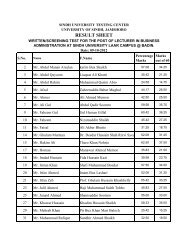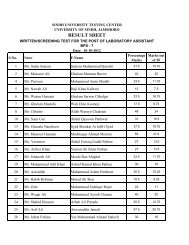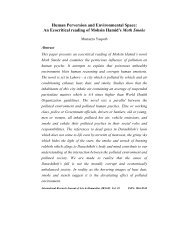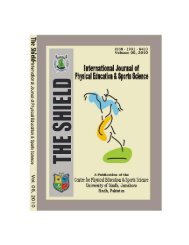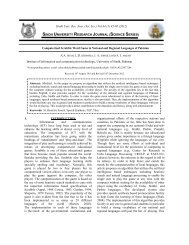Spring Zooplankton Composition of Rawal Lake, Islamabad W. A. ...
Spring Zooplankton Composition of Rawal Lake, Islamabad W. A. ...
Spring Zooplankton Composition of Rawal Lake, Islamabad W. A. ...
Create successful ePaper yourself
Turn your PDF publications into a flip-book with our unique Google optimized e-Paper software.
Siizclli Ll~iilb. Res. .Jorrr-. (Sci. Ser.). Vol: 37 (2) 41-36 ( 2005)<br />
<strong>Spring</strong> <strong>Zooplankton</strong> <strong>Composition</strong> <strong>of</strong> <strong>Rawal</strong> <strong>Lake</strong>, <strong>Islamabad</strong><br />
W. A. Baloch. S. I. H. Jafri and A. N. Soomro<br />
Department <strong>of</strong> Fresh Water Biology and Fisheries, University <strong>of</strong> Sindh,<br />
Jamshoro-76080<br />
Abstract<br />
Species composition <strong>of</strong> zooplankton in <strong>Rawal</strong> <strong>Lake</strong> was analyzed during mid spring (April,<br />
7,004). <strong>Lake</strong> water was alkaline (pH 7.7) and TDS value was 388 mgll. <strong>Zooplankton</strong><br />
community was dominated by rotifers, represented by 10 species. Among these Pnrti~~l~ol~.~<br />
corril)lmitcr was most abundant. Other common rotifers were Filinicr loizgivetcr Bi-ac11yor1u.s<br />
c~ulyc~/lor-~~,s f. crriiphicer-os, Po!\,arthra trig10 and A.sploiichncr priocloi~ta. 3 species <strong>of</strong><br />
cladocerans were recorded namely. Bo.rrlziila loiiyiro.stri.v, Ceriodaphnicr conzllta and Aloiza<br />
rcctarrgrrlo. Among copepods only nauplii and copepodid stages were observed and no adult<br />
was seen, hence identification could not be made.<br />
From the zooplankton composition <strong>of</strong> <strong>Rawal</strong> <strong>Lake</strong>, it can be concluded that it is a mesotrophic<br />
I:(Ce, gl.adually changing to eutropliic state.<br />
Keywords: <strong>Zooplankton</strong>, diversity, Raw1 <strong>Lake</strong>.<br />
<strong>Rawal</strong> lake is a man made water<br />
reservoir, located across Korang river<br />
at a distance <strong>of</strong> about 10 km from<br />
<strong>Rawal</strong>pindi. The lake is formed by a<br />
dam and is situated at latitude 33O.42'<br />
N, longititude 73O.07' E at an altitude<br />
<strong>of</strong> 1800m (Leghari et nl., 2004). The<br />
surface area <strong>of</strong> lake is about 5 km'<br />
(Ahmed et (11.. 1985). This lake serves<br />
as a source <strong>of</strong> drinking water for twin<br />
cities <strong>of</strong> <strong>Rawal</strong>pindi and <strong>Islamabad</strong>. It<br />
is therefore very important to keep the<br />
quality <strong>of</strong> water good for human<br />
consumption.<br />
<strong>Zooplankton</strong> play an important role in<br />
any aquatic ecosystem. They not only<br />
transfer energy from primary<br />
producers to higher order consumers<br />
like macro crustaceans, insects and<br />
small fish, but some species are<br />
considered good indicators <strong>of</strong> trophic<br />
status <strong>of</strong> water bodies. No work on<br />
zooplankton community <strong>of</strong> <strong>Rawal</strong><br />
lake has so far been done. However,<br />
some notable work on freshwater<br />
zooplankton in Pakistan was done by<br />
Baqai et nl., (1973), Akhtar and Ali<br />
(1976), Iqbal and Kazmi (1990),<br />
Mahar et crl., (2000), Baloch (2000),<br />
Baloch and Soomro (2004) and Baloch<br />
et nl., (2004).<br />
The present study primarily aims to<br />
document the zooplankton species<br />
composition <strong>of</strong> <strong>Rawal</strong> lake especially<br />
in early spring season.<br />
Materials and Methods<br />
Samples for water quality and<br />
zooplankton were collected in April<br />
2004, from surface area at different<br />
locations. All the samples were<br />
collected using plankton net having a<br />
mesh size <strong>of</strong> 55p. The samples were<br />
preserved on the spot with 5%<br />
formalin and were pooled in one<br />
sample. All the zooplankton were<br />
identified up to species or genera level,<br />
using keys and illustrations given by<br />
Ward and Whipple (1959), Mizuno<br />
(1964), Mizuno and Takahashi (1991)<br />
and Battish (1992).
W. A. Baloch, et a1<br />
Water quality parameters such as<br />
temperature, pH, TDS, electric<br />
conductivity and salinity were<br />
measured using digital meters.<br />
Temperature, electric conductivity and<br />
salinity were recorded using a portable<br />
digital conductivity - meter (Cond<br />
315i/SET, WTW), while pH was<br />
measured using digital pH meter<br />
(Ecoscan pH5).<br />
Results and Discussion<br />
The lake water was slightly alkaline<br />
(pH 7.7). According to Previous<br />
studies, pH value does not increase<br />
more than 8.5 (Ahmed et al., 1985;<br />
Leghari et al., 2004). The total<br />
dissolved solids (TDS) were recorded<br />
as 288 mg/l and electric conductivity<br />
was 383 lS/cm (Table 1). Water<br />
quality indicated that this lake is in<br />
early stage <strong>of</strong> eutrophication (Ahmed<br />
et al., 1985). Salinity was found to be<br />
0.1 ppt.<br />
A total <strong>of</strong> 13 zooplankton species were<br />
identified. These included 10 species<br />
<strong>of</strong> rotifera and 3 species <strong>of</strong> cladocera<br />
(Table 2). Among rotifers Pompholyx<br />
complanta was most abundant, while<br />
Keratella valga tropica secondly<br />
dominated in the community. The<br />
other common rotifer species were B.<br />
calyciflorus f. amphiceros, Filinia<br />
longiseta, Polyarthra trigla and<br />
Asplanchna priodonta. However,<br />
Keratella cochlearis var. tecta,<br />
Diurella sp. Brachionus calyciflorus f.<br />
clorcas contributed very low<br />
populations.<br />
Apart from rotifera, three species <strong>of</strong><br />
cladocerans were also present in the<br />
lake, these included Bosmina<br />
lo~zgirostris, that contributed with<br />
higher population. Alona rectangula<br />
and Ceriodeplznia cornuta were also<br />
present with low populations. The<br />
naupliar and copepodid stages <strong>of</strong><br />
copepods were also observed but adult<br />
population was not seen.<br />
The community structure <strong>of</strong><br />
zooplankton showed a mixed<br />
composition <strong>of</strong> mesotrophic to<br />
eutrophic species. Species like<br />
F. longiseta and K. cochlearis var.<br />
tecta are considered to be indicator <strong>of</strong><br />
eutrophication (Pejler, 1957; Baloch<br />
et al., 2000). Mostly the Brachionous<br />
species are also found in eutrophic<br />
environments (Hakkari, 1978; Gannon<br />
and Stemberger, 1978; Maemets, 1983;<br />
Baloch et al., 2004). On the other hand<br />
species like K.valga tropica and<br />
P. complanta are usually found in<br />
mesotrophic environments, the former<br />
being abundant in riverine systems<br />
(Beach, 1960; Baloch, 2000; Baloch<br />
and Soomro, 2004).<br />
Abundance <strong>of</strong> mesotrophic species,<br />
K.valga tropica revealed that the lake<br />
is not yet completely eutrophic.<br />
However, presence <strong>of</strong> eutrophic<br />
indicator species, K.cochlearis var.<br />
tecta and F. longiseta indicated that the<br />
trend is going from mesotrophic to<br />
eutrophic. Previous studies (Ahmed<br />
et al., 1985) also showed that the<br />
higher quantities <strong>of</strong> phosphate are<br />
being added to lake through<br />
catchments area during rainy season,<br />
resulting into phytoplankton blooms.<br />
Such type <strong>of</strong> temporary eutrophication,<br />
sometimes occur in lakes surrounded<br />
by agricultural lands, as it was<br />
observed in a Japanese caldera lake<br />
(Baloch, 1998).<br />
Phosphorous is considered to be<br />
limiting factor for phytoplankton in<br />
natural environments. Sufficient<br />
quantities <strong>of</strong> phosphorous are present<br />
throughout the year in lake (Ahmed<br />
et al., 1985). Among Cladocerans,
<strong>Spring</strong> <strong>Zooplankton</strong> <strong>Composition</strong> <strong>of</strong> <strong>Rawal</strong> Luke, <strong>Islamabad</strong> 43<br />
B. lorzgirostris and Ceriodephnia From the zooplankton community<br />
comuta are lacustrine species, former structure <strong>of</strong> <strong>Rawal</strong> lake it can be<br />
occurs usually in mesotrophic to concluded that it is a mesotrophic lake<br />
eutrophic environments (Swar and gradually changing to eutrophic stage.<br />
Fernando, 1980), while C. comuta is a Further studies <strong>of</strong> zooplankton on<br />
s<strong>of</strong>twater, oligotrophic species. seasonal basis are required for better<br />
Another cladoceran Alona rectangula understanding <strong>of</strong> the lake environment<br />
is a creeping species usually occurring<br />
in shallow and weedy areas.<br />
Table 1: Some physico-chemical parameters <strong>of</strong> <strong>Rawal</strong> lake.<br />
Water quality parameters<br />
Water temperature<br />
Electrical Conductivity 383pSlcm<br />
I Salinity<br />
Table 2: <strong>Zooplankton</strong> species and their occurrence.<br />
KNO. I ZOOPLANKTON I OCCURRENCE 1<br />
1<br />
2<br />
3<br />
4<br />
5<br />
6<br />
7<br />
8<br />
9<br />
10<br />
11<br />
( Rotifera<br />
Asplanchna priodonta<br />
Braclzionus calycijlorus f. amphiceros<br />
Brachionus calycijlorus f. dorcas<br />
Conochiloides sp.<br />
Diurella sp.<br />
Filinia longiseta<br />
Keratella cochlearis var. tecta<br />
Keratella valga tropica<br />
Polyarthra trigla<br />
~ornpholyx coplanta<br />
I Cladocera<br />
Alona rectangula<br />
++<br />
++<br />
+<br />
+<br />
+<br />
++<br />
+<br />
+++<br />
++<br />
++++<br />
+<br />
I<br />
(<br />
12<br />
13<br />
Bosmina lon,qirostris<br />
1 Ceriodaplznia carnuta<br />
Copepoda<br />
Nauplii and Copepodid stages<br />
++<br />
+<br />
++<br />
++++ abundant +++ fairly present ++ common + rare
W. A. Baloch, et a1<br />
References<br />
Ahmed. M. M., A. Barlas and Q. J.<br />
Iqbal, (1985) Some physico-chemical<br />
variables <strong>of</strong> <strong>Rawal</strong>, lake <strong>Islamabad</strong>. Pak.<br />
J. Zool., 17 (3), 313-316.<br />
Akhter, S. and S. R. Ali, (1976) The<br />
rotifers <strong>of</strong> Pakistan I. Bull. Hydrobiol.<br />
Res. Gordon college Ser., 1: 1 12-122.<br />
Baloch, W. A. (2000) Occurrence <strong>of</strong><br />
planktonic communities in River Indus<br />
at Kotri barrage, Sindh, Pakistan. Proc.,<br />
Zool., Congress 2000.<br />
Baloch, W. A. and A.N.Soomro, (2004)<br />
Rotifers <strong>of</strong> the adjacent areas <strong>of</strong><br />
Hyderabad, Sindh. Pak. J. Zool., 36 (4):<br />
319-322.<br />
Baloch, W. A., A. N. Soomro and S.I.H.<br />
Jafri, (2004): <strong>Zooplankton</strong> <strong>of</strong> highly<br />
saline water, near Hyderabad. Sind.<br />
Univ. Res. Jour. (Sci. Ser.), 36 (1)<br />
25-28.<br />
Baloch, W.A., H. Maeda and T. Saisho,<br />
(1998) Seasonal abundance and vertical<br />
distribution <strong>of</strong> zooplankton in <strong>Lake</strong><br />
Ikeda, Southern Japan. Microbes<br />
Environ., 13 (I), 1-8.<br />
Baloch, W.A., H. Suzuki and Y. Onoue,<br />
(2000) Occurrence <strong>of</strong> planktonic rotifer<br />
Filinia longiseta in Southern Kyushu,<br />
Japan. Pak. J. Zool., 32 (3), 279-281.<br />
Baqai, I. U., P. A. Siddiqui and M. Iqbal,<br />
(1974) Limnological studies <strong>of</strong> Haleji<br />
lake. Agri. Pakistan, 2: 321-344.<br />
Battish, S. K. (1992) Freshwater<br />
<strong>Zooplankton</strong> <strong>of</strong> India. Oxford and IBH<br />
Publishing Co. Pvt. Ltd. N. Delhi.<br />
Beach, N. W. (1960) A study <strong>of</strong> the<br />
planktonic rotifers <strong>of</strong> the Presque Isle<br />
County, Michigan. Ecol. Monogr., 30:<br />
339-357.<br />
Gannon, J. E. and R. S. Stemberger,<br />
(1978) <strong>Zooplankton</strong>. (Especially<br />
crustaceans and rotifers) as indicator <strong>of</strong><br />
water quality. Trans. Anz. Illicros. Soc.,<br />
97: 16-35.<br />
Hakkari, L. (1978) On the productivity<br />
and ecology <strong>of</strong> zooplankton and its role<br />
as food for fish in some lakes in central<br />
Finland. Biol. Res. Rep. Univ. GyvasX3~ln<br />
4: 3-87.<br />
Iqbal, M. and M. A. Kazmi, (1990)<br />
Cladocera <strong>of</strong> Hub lake with notes on<br />
species and size composition. Sarlzad J.<br />
Agri, 6: 85-88.<br />
Leghari, M. K, M. Y. Leghari and S. M.<br />
Leghari, (2004) Water chemistry and its<br />
relation with algae <strong>of</strong> <strong>Rawal</strong> Dam,<br />
<strong>Islamabad</strong> and Wah garden, District<br />
Attock Sind. Univ. Res. Jour. (Sci. Ser.),<br />
36 (2): 29-48.<br />
Maemets, A. (1983) Rotifers as<br />
indicators <strong>of</strong> <strong>Lake</strong> types in Estonia.<br />
Hydrobiologia 104: 357-361.
<strong>Spring</strong> <strong>Zooplankton</strong> <strong>Composition</strong> <strong>of</strong> <strong>Rawal</strong> <strong>Lake</strong>, <strong>Islamabad</strong><br />
Mahar, M.A., W.A. Baloch and S.I.H.<br />
Jafri, (2000) Diversity and seasonal<br />
occurrence <strong>of</strong> planktonic rotifers in<br />
Manchar lake, Sindh, Pakistan. Pakistan<br />
J. fish. l(1): 25-32.<br />
Mizuno, T. and E. Takahashi, (1991)<br />
an illustrated guide to Freshwater<br />
<strong>Zooplankton</strong> in Japan. Tokai University<br />
Press.<br />
Mizuno, T. (1964) Illustrations <strong>of</strong><br />
freshwater plankton <strong>of</strong> Japan. Hoikusha.<br />
Pejler, B. (1957) Taxonornical and<br />
Ecological studies on planktonic rotitoria<br />
from central Sweden. K. Svenska<br />
vetensk. Akad. Handl., 6 (7): 52 pp.<br />
Swar, B. D. and C. H. Famando, (1980)<br />
Some studies on the ecology <strong>of</strong> limnetic<br />
crustaceaus zoolplankton in lakes<br />
Begeras and Recepa, Pakhara Valley,<br />
Nepal. Hyderobiologia, 70: 235-245.<br />
Ward, H. B. and Whipple, G. C.,<br />
(1959) Freshwater Biology. John<br />
Wiley and Sons.



